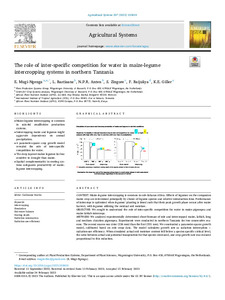| dc.contributor.author | Mugi-Ngenga, E. |
| dc.contributor.author | Bastiaans, L. |
| dc.contributor.author | Anten, N.P.R. |
| dc.contributor.author | Zingore, S. |
| dc.contributor.author | Baijukya, F. |
| dc.contributor.author | Giller, K. |
| dc.date.accessioned | 2023-06-06T09:46:57Z |
| dc.date.available | 2023-06-06T09:46:57Z |
| dc.date.issued | 2023-04 |
| dc.identifier.citation | Mugi-Ngenga, E., Bastiaans, L., Anten, N.P.R., Zingore, S., Baijukya, F. & Giller, K. (2023). The role of inter-specific competition for water in maize-legume intercropping systems in northern Tanzania. Agricultural Systems, 207: 103619, 1-18. |
| dc.identifier.issn | 0308-521X |
| dc.identifier.uri | https://hdl.handle.net/20.500.12478/8198 |
| dc.description.abstract | CONTEXT Maize-legume intercropping is common in sub-Saharan Africa. Effects of legumes on the companion maize crop are determined principally by choice of legume species and relative introduction time. Performance of intercrops is optimized when legumes' planting is timed such that their peak growth phase occurs after maize harvest, with legumes utilizing the residual soil moisture. OBJECTIVE We sought to understand the role of inter-specific competition for water in maize-pigeonpea and maize-lablab intercrops. METHODS We analysed experimentally determined shoot biomass of sole and intercropped maize, lablab, long and medium- duration pigeonpea. Experiments were conducted in northern Tanzania for two consecutive seasons. The second season was drier (236 mm) than the first (551 mm). We constructed a parameter-sparse growth model, calibrated based on sole crops data. The model calculates growth rate as radiation interception × radiation-use efficiency. When simulated actual soil moisture content fell below a species-specific critical level, the ratio between actual and potential transpiration for that species decreased, and crop growth rate was reduced proportional to this reduction. RESULTS AND CONCLUSIONS There was good agreement between simulated and observed shoot biomass of maize and the legumes. With rooting depth of 60 cm, maize was simulated to be sensitive to annual precipitation, resulting in 3.5 t ha−1 (34%) reduction in shoot dry matter production in the second season. By contrast, the legumes, with a rooting depth of 200 cm did not experience water shortage in either of the two seasons, resulting in nearly identical shoot dry matter production in both seasons. Explorative simulations assuming the legumes to have shallower rooting depth confirmed the importance of this trait for avoidance of water stress, with simulated reductions in dry matter production of 23–34% for the legumes when rooting depth was reduced from 200 to 60 cm. Maize in the intercrop was modestly influenced by the legumes due to light competition. In the low precipitation season, additional competition for water occurred and water shortage for maize was aggravated. Maize influenced the legumes only through competition for light, as a tap root allowed the legumes to utilize water stored in deeper soil layers. During the co-growth period, competition for light exerted by maize on the legumes was strong, but they partly compensated for this in the period after maize harvest. SIGNIFICANCE Our results emphasize the important role of the deep legume tap root for the success of maize-legume intercrops under rain-fed conditions. |
| dc.description.sponsorship | African Plant Nutrition Institute |
| dc.description.sponsorship | United States Agency for International Development |
| dc.format.extent | 1-18 |
| dc.language.iso | en |
| dc.subject | Intercropping |
| dc.subject | Simulation |
| dc.subject | Soil Water Balance |
| dc.subject | Rooting |
| dc.subject | Radiation |
| dc.subject | Tanzania |
| dc.title | The role of inter-specific competition for water in maize-legume intercropping systems in northern Tanzania |
| dc.type | Journal Article |
| cg.contributor.crp | Grain Legumes |
| cg.contributor.affiliation | Wageningen University and Research Centre |
| cg.contributor.affiliation | African Plant Nutrition Institute |
| cg.contributor.affiliation | International Institute of Tropical Agriculture |
| cg.coverage.region | Africa |
| cg.coverage.region | East Africa |
| cg.coverage.country | Tanzania |
| cg.coverage.hub | Eastern Africa Hub |
| cg.researchtheme | Natural Resource Management |
| cg.identifier.bibtexciteid | MUGINGENGA:2023 |
| cg.isijournal | ISI Journal |
| cg.authorship.types | CGIAR and developing country institute |
| cg.iitasubject | Agronomy |
| cg.iitasubject | Food Security |
| cg.iitasubject | Grain Legumes |
| cg.iitasubject | Maize |
| cg.iitasubject | Smallholder Farmers |
| cg.journal | Agricultural Systems |
| cg.notes | Open Access Article; Published online: 24 Feb 2023 |
| cg.accessibilitystatus | Open Access |
| cg.reviewstatus | Peer Review |
| cg.usagerightslicense | Creative Commons Attribution 4.0 (CC BY 0.0) |
| cg.targetaudience | Scientists |
| cg.identifier.doi | https://doi.org/10.1016/j.agsy.2023.103619 |
| cg.iitaauthor.identifier | Frederick Baijukya: 0000-0003-2586-2013 |
| cg.futureupdate.required | No |
| cg.identifier.issue | 103619 |
| cg.identifier.volume | 207 |

